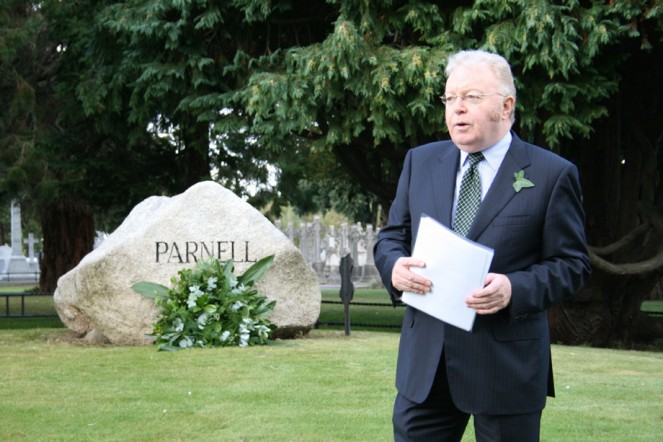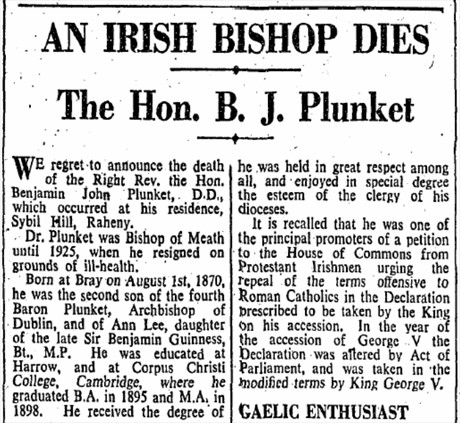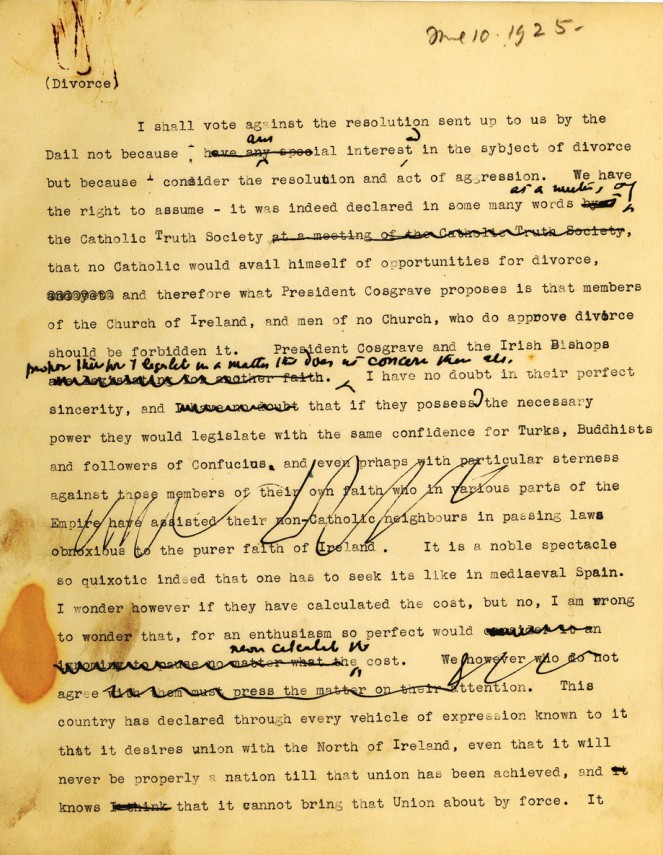by FELIX M. LARKIN, Vice-chair of the NLI Society and member of the NLI’s Readers Advisory Committee
When I was at school in St Paul's College, Raheny, the imp in me was always amused by the fact that the old house in the grounds of the school – where the Vincentian priests who ran the school lived – had once been the home of a Church of Ireland bishop. The bishop in question was Benjamin Plunket, Bishop of Meath from 1919 to 1925. So, when the opportunity arose to write about Bishop Plunket for the Dictionary of Irish Biography, I happily volunteered. He turned out to be a very interesting character, and I even discovered links with W.B. Yeats and John F. Kennedy.

Felix M. Larkin delivering the address at the Ivy Day commemoration of the death of Charles Stewart Parnell in Glasnevin Cemetery, 4 October 2009
Bishop Plunket was born in 1870. He was the younger son of the 4th Baron Plunket, Archbishop of Dublin from 1884 to 1897, whose statue stands in Kildare Place – at the back of the National Museum. His mother was Anne Lee Guinness, only daughter of Sir Benjamin Lee Guinness and sister of Lord Ardilaun and the 1st Earl of Iveagh. Educated at Harrow and Corpus Christi College, Cambridge, he was ordained by his father in 1896. He held a number of curacies before being appointed vicar of St. Ann’s, Dawson Street, in 1907. He became Bishop of Tuam, Killala and Achonry in 1913, and transferred to the diocese of Meath in 1919.

Statue of 4th Baron Plunket, father of Benjamin Plunket at Kildare Place, Dublin (NLI Lawrence Royal Collection 7309)
The Irish Times, when reporting his death, characterised Plunket as ‘a Churchman of broad views … [who] was not afraid to utter his opinions’. Probably his most notable stand was in 1910 when, on the accession of King George V, parliament passed an act to delete terms offensive to Roman Catholics from the Royal Accession Declaration. The old Declaration, introduced in 1678, repudiated the Mass, transubstantiation and the invocation of the Virgin Mary and the saints. The modified form of the Declaration was widely opposed, but Plunket was the principal promoter of a petition to the House of Commons in support of it, signed by over 3,000 representative Irish Protestants.
On another occasion, he was one of three Church of Ireland bishops who, with eighteen Catholic bishops, signed a controversial anti-partition manifesto issued before the Longford by-election of May 1917; the manifesto was a significant factor in Sinn Fein’s narrow victory in the by-election. Plunket was also an Irish language enthusiast, encouraging Irish in Church of Ireland schools and hymns in Irish at church services.

Notice of death of Benjamin Plunket, Bishop of Meath in the Irish Times, 27 January 1947
In 1925, while still Bishop of Meath, he was severely criticised by W.B. Yeats in the latter’s famous speech in the Senate on divorce. Plunket’s uncompromising approach to sexual morality and the indissolubility of marriage had, as Yeats saw it, given succour to those intent on passing legislation which the Protestant minority would find oppressive. Shortly afterwards, he resigned as Bishop of Meath on health grounds. He was then aged 55, and had just inherited the 500-acre estate of his late uncle, Lord Ardilaun, at St Anne’s, Clontarf. Ardilaun had no children, and his widow died in 1925.
After a long recuperation abroad, Plunket moved into the Italianate mansion on the estate – described by Mark Bence-Jones as ‘the most palatial house to be built in Ireland during the second half of the nineteenth century’. He lived there – somewhat uneasily – till 1939. Neither he nor his family were comfortable in such opulent surroundings, and the maintenance of the house was an impossible burden for him. He made several unsuccessful attempts to sell the estate in the 1930s. Eventually, Dublin Corporation acquired it by compulsory purchase and turned part of the lands into a public park, using the remainder for new housing. The mansion was destroyed by fire in 1943, though its shell was still there when I was at school in St Paul's and I remember well playing in the ruins. It was demolished in 1968.

Working Draft of W.B. Yeats Divorce Speech, dated 10 June 1925 (NLI Yeats Collection)
Sybil Hill, a dower house within the St Anne’s estate, was excluded from the compulsory purchase – with twenty-two adjoining acres. An elegant late-Georgian building, Plunket retained it as his final residence. He died in January 1947 and is buried in the grounds of All Saints’ Church, Raheny (formerly the St Anne’s estate chapel). His second son, also Benjamin, inherited Sybil Hill and later sold it to the Vincentian congregation, who established St Paul’s College there in 1950.
Bishop Plunket had two sons and two daughters. The younger daughter, Olive, married the 8th Earl Fitzwilliam in 1933. Their marriage was not a success, she became an alcoholic and he had a number of well-publicised affairs – the last with Kathleen, widow of William, Marquis of Hartington (heir to the Duke of Devonshire), and a sister of John F. Kennedy. Kathleen and Fitzwilliam were killed in 1948 when the private plane in which they were travelling together crashed in France.
